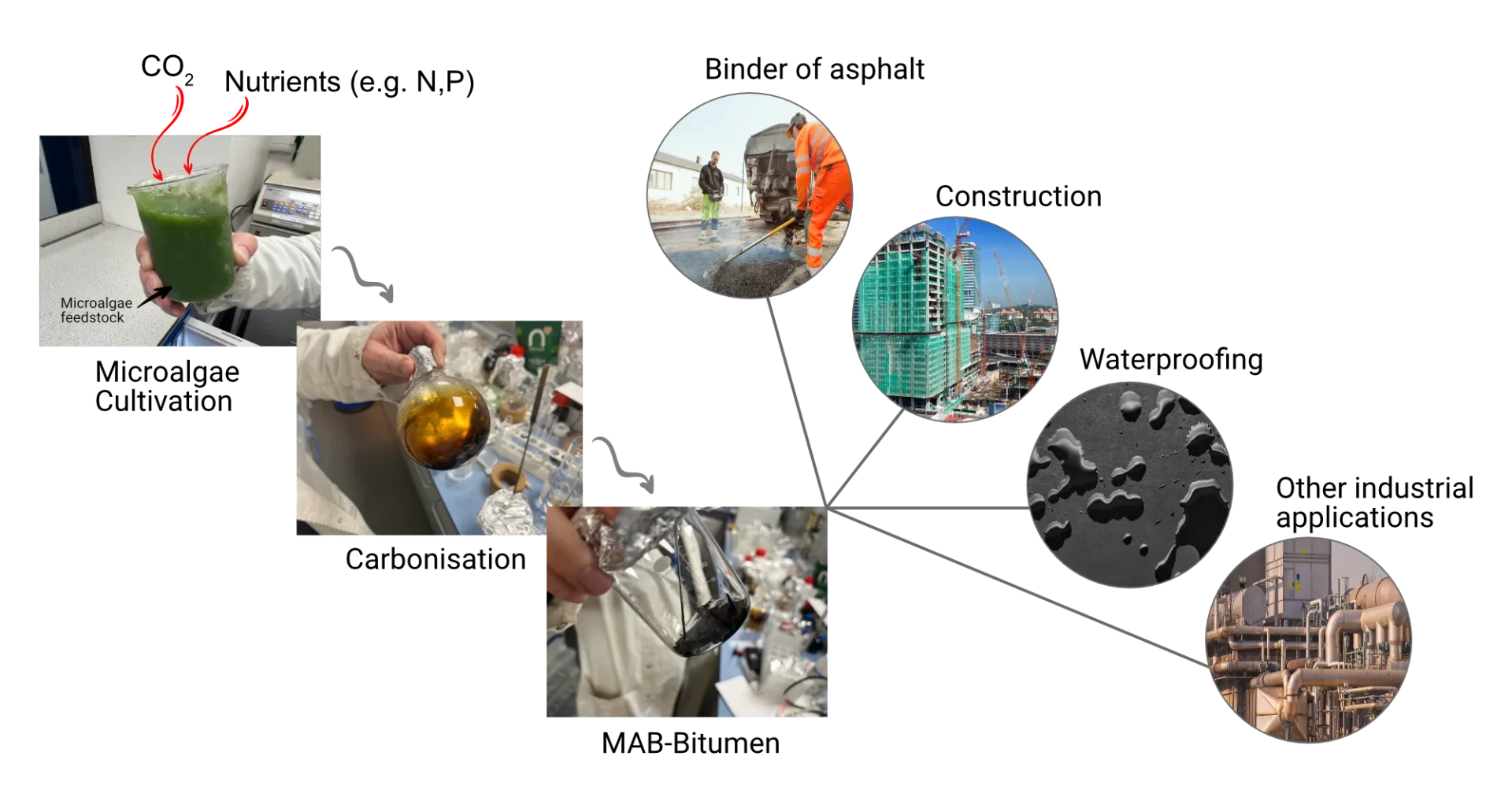Background
Bitumen is a viscous, sticky substance extracted from crude oil. It is an important material used as an asphalt binder for road construction and other paved areas. It is also used in other various civil engineering applications, such as adhesives, sealants, preservatives, and waterproofing agents. The estimated global annual production of bitumen is 130 million metric tonnes. According to Eurobitume, the EU produces around 15 million metric tonnes of bitumen every year. The UK produces about 727,000 metric tonnes and imports around 1.2 million metric tonnes (Statista, 2021). For road construction, sticky bitumen is mixed with aggregates such as crushed rock, sand and gravel to create asphalt, which binds it all together to build roads. The US National Asphalt Pavement Association (EAPA) in “Asphalt in Figures 2021” reports that an average of approximately 624 million tons of asphalt are produced every year, only between Europe, the US and South Africa.
Eurobitume asserts that bitumen is a sustainable construction material, has a minimal environmental impact during its use/service phase, and, as an asphalt binder, is entirely reusable. However, Eurobitume estimated 208 kg CO2e/t bitumen, whereas ESU-services Ltd estimated 720 kg CO2e/t bitumen in a separate study (Jungbluth et al 2019). Estimating that each ton of asphalt contains 4% of bitumen, and 25kg of CO2 per tonne of asphalt (direct emission according to Hanson UK, 2022), the annual global production of asphalt is estimated to produce an equivalent of 15.6 million tons of CO2 emission, with approximately 5 million tonnes (or around 17 million tons using ESU figures) from bitumen alone.
Apart from environmental concerns, the depletion of crude oil reserves is a serious issue for the construction and waterproofing industries. Therefore, the development of new sustainable alternatives for petroleum-based bitumen is urgently needed to help road industries cut carbon emissions and reach net-zero carbon targets by 2050 (see the National Highway’s Net Zero 2030/240/2050 plan).
The ‘MAB-Bitumen’ project is committed to finding innovative solutions to this problem by creating pioneering grades of bio-based bitumen for different industrial and engineering applications. Through our collaboration with leading industries and academia, we are determined to pilot, develop, and scale up our technology, paving the way for a more sustainable future.
What is MAB-Bitumen?
Microalgal-based biohybrid bitumen (MAB-Bitumen) is a novel bio-based bituminous material that is produced by using specific strains of microalgae either alone or blended with other bio-based materials. The resulting material offers numerous advantages over conventional bitumen, including superior mechanical properties, environmental sustainability, and cost-effectiveness.
Microalgae are tiny photosynthetic organisms that grow quickly and absorb high amounts of CO2. They can also assimilate nutrients like nitrogen and store excess phosphate inside their cells, and they have a high capacity for producing lipids. Our MAB-bitumens are created by partially carbonising the initial algal biomass in an oxygen-limited environment to make carbon- and lipid-rich material. The high lipid and nutrient content in the MAB-bitumens makes them highly attractive due to their viscoelastic and adhesive properties, which are similar to those found in petroleum-based bitumen. This material has unique characteristics, and our ability to adjust its chemical and visco-elastic properties makes it suitable for various industrial applications, including road construction and waterproofing.

Fig1: Schematic illustrating the process of creating our MAB-Bitumen material and its industrial applications.
Consortium Team
Together with CO2CO, Nanolyse Technologies Ltd, Imperial College London, the University of Sheffield and UK asphalt industry leaders, we form a powerful collaborative consortium committed to driving innovation and creating a better, more sustainable future. The MAB-Bitumen executive team and partners are shown below.

Imad Ahmed
Chief Executive Director
Nanolyse Technologies Ltd

Philip Slaughter
Chief Executive Director
CO2CO Ltd

Sarmad Qureshi
CO2CO Ltd

Mark Sephton
Imperial College London

University of Sheffield
Project Details
Funder: Innovate UK
Programme: Sustainable bio-based materials and manufacture (SusBioMM).
Feasibility Study Title: Microalgal biomass as a sustainable alternative to bitumen in road construction.
Date Started: 01 July 2023
Type: Feasibility study involving material development, market research, and business development.
Project Coordinator/Lead: CO2CO Ltd
Next phase: R&D + Pilot Trials
Communication Materials
Downloadable materials will be available soon.
Frequently Asked Questions
Is Bitumen the same as asphalt?
No, bitumen is the binding agent for asphalt. Here are some of the key differences:
- Bitumen is the glue, while asphalt is the finished product.
- Bitumen is a single component, while asphalt is a mixture.
- Bitumen is liquid, while asphalt is solid (at room temperature).
- Bitumen is primarily composed of hydrocarbons, with some sulfur and other elements, whereas asphalt is typically 4-8% bitumen and 92-96% aggregates and fillers.
What is warm mix asphalt?
Warm mix asphalt (WMA) is a type of asphalt that is produced and used at significantly lower temperatures compared to traditional hot mix asphalt (HMA). This temperature reduction offers several advantages for both the environment and workers involved in road construction and maintenance
- Production: WMA incorporates special additives or foaming technologies during the mixing process. These additives lower the asphalt's viscosity (thickness) at lower temperatures, allowing it to coat the aggregates effectively without requiring high heat.
- Application: WMA can be applied at temperatures ranging from 20°C to 40°C lower than HMA, depending on the specific mix design and additives used. This reduction in temperature translates to several benefits:
Is Tar and Bitumen are the same?
Tar and bitumen, though often confused, are distinct substances with different origins, properties, and applications. Here's a breakdown to help you understand the key differences:
Origin:
- Tar: Derived from the carbonization of organic materials like coal, wood, or peat.
- Bitumen: Naturally occurring black viscous liquid found in petroleum deposits.
Composition:
- Tar: Contains a complex mixture of organic compounds, including aromatic hydrocarbons, phenols, and heterocyclic nitrogen compounds.
- Bitumen: Primarily consists of hydrocarbons, with some sulfur and other elements.
